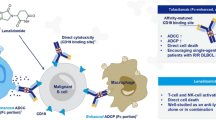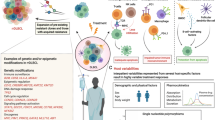Abstract
The two major subtypes of diffuse large B cell lymphoma (DLBCL)—activated B cell–like (ABC) and germinal center B cell–like (GCB)—arise by distinct mechanisms, with ABC selectively acquiring mutations that target the B cell receptor (BCR), fostering chronic active BCR signaling1. The ABC subtype has a ∼40% cure rate with currently available therapies, which is worse than the rate for GCB DLBCL, and highlights the need for ABC subtype-specific treatment strategies2. We hypothesized that ABC, but not GCB, DLBCL tumors would respond to ibrutinib, an inhibitor of BCR signaling. In a phase 1/2 clinical trial that involved 80 subjects with relapsed or refractory DLBCL, ibrutinib produced complete or partial responses in 37% (14/38) of those with ABC DLBCL, but in only 5% (1/20) of subjects with GCB DLBCL (P = 0.0106). ABC tumors with BCR mutations responded to ibrutinib frequently (5/9; 55.5%), especially those with concomitant myeloid differentiation primary response 88 (MYD88) mutations (4/5; 80%), a result that is consistent with in vitro cooperation between the BCR and MYD88 pathways. However, the highest number of responses occurred in ABC tumors that lacked BCR mutations (9/29; 31%), suggesting that oncogenic BCR signaling in ABC does not require BCR mutations and might be initiated by non-genetic mechanisms. These results support the selective development of ibrutinib for the treatment of ABC DLBCL.
This is a preview of subscription content, access via your institution
Access options
Subscribe to this journal
Receive 12 print issues and online access
$209.00 per year
only $17.42 per issue
Buy this article
- Purchase on Springer Link
- Instant access to full article PDF
Prices may be subject to local taxes which are calculated during checkout



Similar content being viewed by others
References
Shaffer, A.L. III, Young, R.M. & Staudt, L.M. Pathogenesis of human B cell lymphomas. Annu. Rev. Immunol. 30, 565–610 (2012).
Lenz, G. et al. Stromal gene signatures in large-B-cell lymphomas. N. Engl. J. Med. 359, 2313–2323 (2008).
Davis, R.E., Brown, K.D., Siebenlist, U. & Staudt, L.M. Constitutive nuclear factor kappa B activity is required for survival of activated B cell-like diffuse large B cell lymphoma cells. J. Exp. Med. 194, 1861–1874 (2001).
Davis, R.E. et al. Chronic active B-cell-receptor signalling in diffuse large B-cell lymphoma. Nature 463, 88–92 (2010).
Ngo, V.N. et al. Oncogenically active MYD88 mutations in human lymphoma. Nature 470, 115–119 (2011).
Lenz, G. et al. Oncogenic CARD11 mutations in human diffuse large B cell lymphoma. Science 319, 1676–1679 (2008).
Compagno, M. et al. Mutations of multiple genes cause deregulation of NF-kappaB in diffuse large B-cell lymphoma. Nature 459, 717–721 (2009).
Yang, Y. et al. Exploiting synthetic lethality for the therapy of ABC diffuse large B cell lymphoma. Cancer Cell 21, 723–737 (2012).
Sehn, L.H. et al. The revised International Prognostic Index (R-IPI) is a better predictor of outcome than the standard IPI for patients with diffuse large B-cell lymphoma treated with R-CHOP. Blood 109, 1857–1861 (2007).
Loiarro, M. et al. Peptide-mediated interference of TIR domain dimerization in MyD88 inhibits interleukin-1-dependent activation of NF-κB. J. Biol. Chem. 280, 15809–15814 (2005).
Young, R.M. & Staudt, L.M. Targeting pathological B cell receptor signalling in lymphoid malignancies. Nat. Rev. Drug Discov. 12, 229–243 (2013).
Schmitz, R. et al. Burkitt lymphoma pathogenesis and therapeutic targets from structural and functional genomics. Nature 490, 116–120 (2012).
Byrd, J.C. et al. Targeting BTK with ibrutinib in relapsed chronic lymphocytic leukemia. N. Engl. J. Med. 369, 32–42 (2013).
Wang, M.L. et al. Targeting BTK with ibrutinib in relapsed or refractory mantle-cell lymphoma. N. Engl. J. Med. 369, 507–516 (2013).
Quesada, V. et al. Exome sequencing identifies recurrent mutations of the splicing factor SF3B1 gene in chronic lymphocytic leukemia. Nat. Genet. 44, 47–52 (2012).
Beà, S. et al. Landscape of somatic mutations and clonal evolution in mantle cell lymphoma. Proc. Natl. Acad. Sci. USA 110, 18250–18255 (2013).
Wang, L. et al. SF3B1 and other novel cancer genes in chronic lymphocytic leukemia. N. Engl. J. Med. 365, 2497–2506 (2011).
Cheson, B.D. et al. Revised response criteria for malignant lymphoma. J. Clin. Oncol. 25, 579–586 (2007).
Acknowledgements
This research was supported in part by the Intramural Research Program of the United States National Institutes of Health, National Cancer Institute, Center for Cancer Research. Research grant was provided by the Dr. Mildred Scheel Stiftung für Krebsforschung (Deutsche Krebshilfe; R.S.). Medical writing and editorial support were provided by M. Gersh and funded by Janssen Pharmaceuticals, Titusville, New Jersey. These studies, NCT00849654 and NCT01325701, were sponsored by Pharmacyclics, Inc., Sunnyvale, California.
Author information
Authors and Affiliations
Contributions
L.M.S. and W.H.W. conceived of this study, led the clinical trial, analyzed data and wrote the manuscript with D.M.B., R.M.Y., R.S., Y.Y., G.W., S.P., C.-J.L., and P.M.W. A.L.S. performed experiments and analyses. J.G., S.d.V., A.G., V.P.K., P.M.B., K.A.B., A.S., R.A., N.H.F., J.M.V., R.L.E., T.M.H. and J.C.B. enrolled subjects in the clinical trials and reviewed data. J.M., B.Y.C., M.F., F.C., B. M., D.M. and D.M.B. analyzed and reviewed data and provided logistical support for the trial. All authors provided critical review of the manuscript draft and provided final approval for submission.
Corresponding author
Ethics declarations
Competing interests
L.M.S. and J.C.B. have received institutional research funding from Pharmacyclics. L.M.S. and W.H.W. are inventors on a patent application regarding the use of ibrutinib in ABC DLBCL. A.G. has served on advisory boards for Pharmacyclics and Johnson & Johnson and on the speaker's bureau for Johnson & Johnson. N.H.F. has served on advisory board and has received research grants from Pharmacyclics. R.A. has received research grants from Pharmacyclics and Janssen. P.M.B. and J.M.V. have received research grants from Pharmacyclics. R.L.E. is currently an employee of Genentech, Inc. J.M., M.F., B.Y.C., F.C. B.M., D.M., and D.M.B. are employees of Pharmacyclics, Inc. and own stock options. R.M.Y., R.S., Y.Y., S.P., G.W., C.-J.L., P.M.W., A.L.S., J.G., S.d.V., V.P.K., K.A.B., A.S. and T.M.H. declare no competing financial interests.
Supplementary information
Supplementary Text and Figures
Supplementary Figures 1 and 2, Supplementary Table 1 and Supplementary Notes 1–5 (PDF 663 kb)
Rights and permissions
About this article
Cite this article
Wilson, W., Young, R., Schmitz, R. et al. Targeting B cell receptor signaling with ibrutinib in diffuse large B cell lymphoma. Nat Med 21, 922–926 (2015). https://doi.org/10.1038/nm.3884
Received:
Accepted:
Published:
Issue Date:
DOI: https://doi.org/10.1038/nm.3884
This article is cited by
-
Analysis of autophagy in DLBCL reveals subtype-specific differences and the preferential targeting of ULK1 inhibition in GCB-DLBCL provides a rationale as a new therapeutic approach
Leukemia (2024)
-
Zanubrutinib-lenalidomide-rituximab (ZR2) in unfit diffuse large B-cell lymphoma: efficient and tolerant
Annals of Hematology (2024)
-
POU Class 2 Homeobox Associating Factor 1, as a Hub Candidate Gene in OP, Relieves Osteoblast Apoptosis
Applied Biochemistry and Biotechnology (2024)
-
Chinese expert consensus on Bruton tyrosine kinase inhibitors in the treatment of B-cell malignancies
Experimental Hematology & Oncology (2023)
-
The progress of novel strategies on immune-based therapy in relapsed or refractory diffuse large B-cell lymphoma
Experimental Hematology & Oncology (2023)



